Updated 19 Dec 2008
|
WIRKSWORTH Parish Records 1600-1900
|
|
Thomas "TB" BULLIVANT 1811-1872 |
I have laid this page out trying to preserve some of the
excitement looking for and finding someone called
T.B., the loco and boilers he drew.
|
John Slack writes:
These drawings were discovered by accident. They are on the originally
blank reverse of the porters and wagon "returns sheets" printed in
185- and 186- for the C & HPR showing they did not waste paper in those days.
The 2 papers were offered in a postal auction of old railway paperwork.
When I acquired them, they were folded down from A4 and A2 sizes thus
"hiding" the drawings. I opened the first (A4) sheet and espied the
drawing and title but didn't open the bigger one until my inquisitive
engineer friend, Ian Hornsby, "nosed" into it and found the second set.
Another friend, Pete Hall, secretary of the Gt. Northern Railway Society,
saw them and wondered who T.B. was. I contacted
John Rowe, of Matlock Bath, who passed my enquiry on to Andy Pollock,
Peak District Ranger i/c Middleton Top Engine.
Then, I put "Middleton Top Engine" into my Everyclick search engine.
There, I discovered John Palmer's magnificent website on Wirksworth etc.
parish records. Everything escalated from there!
One aspect of this detective story was that I originate from Ripley and
my father from Swanwick (I now live in St. Neots, Cambs.). John Palmer's
parish records show there have been umpteen "John Slacks" in the
Wirksworth area over the centuries, and this chance discovery has given
me the idea that my family may have originated from the
Wirksworth-Middleton area.
You see, Thomas Bullivant, the drawings' creator, married someone from
Pentrich, the village only one mile from Swanwick and owned by the Duke
of Devonshire until 1950'ish. When the lead mines in the Middleton area
began to close down it was at the time when the
Ripley-Butterley-Pentrich-Swanwick coal and ironstone mining industry was expanding rapidly and needed more workers.
Did the Middleton men seek out these jobs?
|
John Slack e-mailed the author:
I have recently acquired two 1850-60s old
unused documents printed for the C & HPRailway.
On the backs are some old draughtsman-quality drawings of engine
boiler and chimney box designs. They were drawn in 1867 and signed
"TB".
Question - having come across your incredibly detailed parish records
on the Internet I wondered if you might know who
TB might have been. To
wade through all the 'B' names would not necessarily have identified
him anyway.
|
The larger drawing has the draughtsman's signature:
"T.B." and the title reads:

The smaller drawing is also signed "T.B."
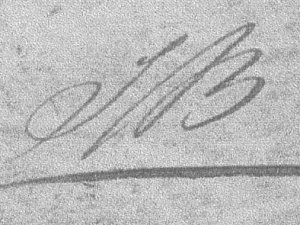
|
I have the Census 1841-1901 for the Wirksworth area on database,
so did a search for someone with initials
"T.B" and something to
do with engines. One man appeared and I searched his records further.
His change of job description from Blacksmith to Engine Smith
seems to sum up the Victorian age.
|
The author replied to John Slack:
Your man is Thomas BULLIVANT, born about 1811
Links to him and his family on my Census are:
1871 Foreman machinist, engine works
1861 Engine Smith
1851 Engineer
1841 Blacksmith
Born 1809 or 1811 at Edwinstowe Notts, father William
Married in 1831 to Sarah Brown of Pentrich
Had 5 children: Charles (1833), Hannah (1835),
Samuel (1837), George (1839), Harriett (1841)
He married again in 1868 to Elizabeth Johnson
His father William was a miner
He died in 1872 aged 62
|
Anyone with more information about Thomas BULLIVANT,
or better still a photo, please contact 
|
|
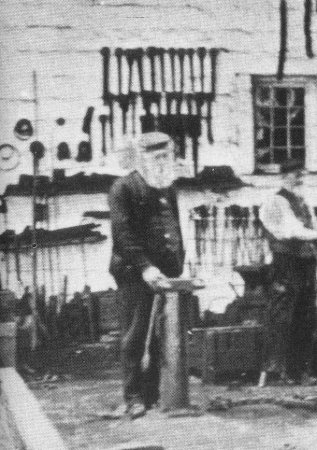 |
A possible Thomas Bullivant |
John Slack writes:
Are you sure Thomas Bullivant died in 1872? A nearby friend
has just let me borrow a booklet entitled "Cromford & High Peak R'y" by
Tony Broome publ. 1985.
The photo, "c.1880" on p5 shows the interior of the Cromford-end
workshop. It contains 4 men one of whom looks set for the grave and
appears to be the man i/c. I just wonder if it is T Bullivant. I
suspect the date is not accurate therefore could have been taken a few
years earlier.
The webmaster replied:
It could be Thomas Bullivant. My source for Thomas' death is FreeBMD which
gives his death as Sep 1872, aged 62, in Bakewell Registration District
(Bakewell RD contains Cromford, where he was working and living in 1871,
and three Census give him a birth year of 1811). I showed my wife the
hirsute gent, and asked her "how old"? She said "60s or 70s", and
"He looks like Uncle Albert in Only Fools and Horses". In FreeBMD
there is no other Thomas Bullivant who is the right age and District.
I've seen the photo many times before, but never connected it with TB.
Well done! I will scan the possible TB and add him to the webpage.

Andy Pollock wrote:
I have now got the picture from JR - thanks very much, it is a very
striking image. Did I tell you that I have shown your drawings to our
engine house crew and they THINK that the boiler is probably not of
C+HPR provenance. They THINK it is of a type which MAY have been in use
in Wirksworth.
The photo you send - Tony Broome is quite right about the probable age of
the photo - it was taken in the 1880's we think - the man at the anvil
with the peg leg is William (?) Hallows who lost his leg in an accident
on Sheep Pasture incline in the 1870/80's and was put on "light duties"
in the workshops at Cromford. This accident is well documented and can
be verified quite easily so the photo is taken after the event. If this
is the case then my maths tell me that the man with the beard cannot
be TB. I would dearly love to find out who all the characters are on
this photo. Photos inside the workshops are not plentiful especially
from the 19th Century.
|
Taken c1872. CHPR Number 2 loco,
supplied by Edward Bury. It replaced
horses on a section of the CHPR in 1860. Note the missing
tender and added saddle tank (fitted later in Crewe).
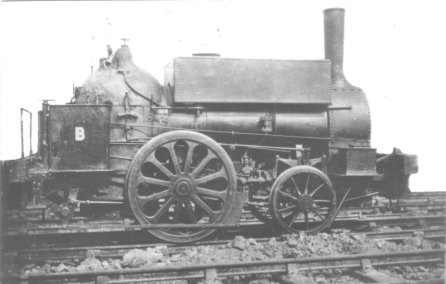
John Marshall writes
In 1835 Edward Bury & Co of Liverpool supplied
a 2-2-0 tender locomotive which became CHPR No 2
(Cromford and High Peak Railway).
It may have been obtained second hand. Cylinders
were 12 x 18 in, driving wheels 4ft 8in, leading
wheels 3ft 0in; length of engine 18ft 6in; engine and
tender 32ft 3in; weight 9½ tons. In 1860 this
locomotive replaced horses on the High Peak Junction -
Sheep Pasture foot section. In June 1864
the boiler was fitted with a new copper firebox at
Longsight, Manchester, and it returned to the CHPR
to the Sheep Pasture foot section where it worked
from 26 January to 10 April 1865. It was then
transferred to the Hopton top - Hurdlow foot section
and remained there until 17 March 1868.
Afterwards it worked on the Sheep Pasture top and
bottom sections. When taken into LNWR stock in
November 1871 it was numbered 2039 but a month
later it became 1942 in the duplicate list of
locomotives. Later it was fitted at Crewe with a
saddle tank and the weight became 5 tons 4 cwt +
8 tons 14 cwt, total 13 tons 18 cwt. In May 1873 it was
transferred to Crewe Locomotive Machinery
Department and given the Letter 'B' (see
photograph) and it shunted at Crewe works until it
was scrapped in May 1876.
'The Cromford & High Peak Railway' by John Marshall.
|
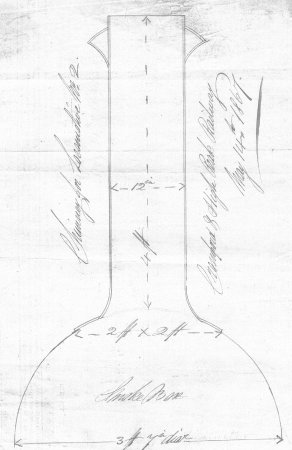 |
[The smaller drawing reads:]
Chimney for Locomotive Nr 2
Cromford & High Peak Railway
May 14th 1867
Smoke Box
[signed] T.B.
|
The CHPR originally had 9 stationary engines, each pulling up an incline.
Counting from the West, Middleton would be number 8.
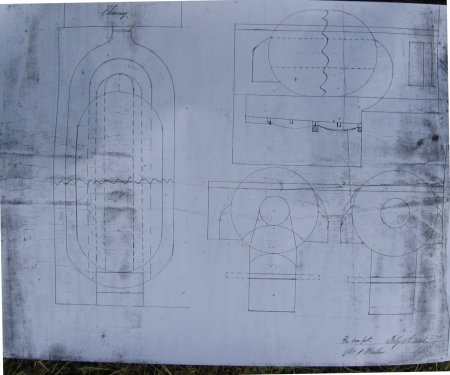 |
[The larger drawing reads:]
Chimney
¾ in. One foot. Feby 1st 1866
No 8 Boilers
[signed] T.B.
|
I.C.Coleford writes in his "Cromford and High Peak Railway"
The winding engine was a two cylinder low-pressure condensing engine
rated at 40hp, virtually identical to those at Cromford and Sheep
Pasture, and its condition was reported on by Edward Reynolds in February
1856: "One of the cylinders has a hole through it, and the other wants
new bottom and valve casings. The condition of the air pumps is uncertain.
Both the boilers are in a very bad state. Aproximate cost of repairs,
including delivering, and erecting the whole: £680"
By 1859 the boiler of the Middleton engine was in dire condition, and so
an old Ramsbottom DX boiler, converted for stationary use and mounted
on the underframe of one of the water tanks, was brought in. This did
not prove to be a long-term solution, as the old locomotive boiler was
condemned only a few years on. By then, much of the traffic on the CHPR
originated near Middleton Foot and was taken via Sheep Pasture Incline,
and it was therefore considered that Middleton Incline could be closed,
thus circumventing the cost of replacing the boiler. An engine shed was
provided at Middleton Top for the locomotives working onwards from there.
It is assumed that this shed was built in 1877 when locomotive working
between Middleton Top and Bunsall was introduced.
|
Compiled, formatted, hyperlinked, encoded,
and copyright © 2008,
 All Rights Reserved.
All Rights Reserved.
|






